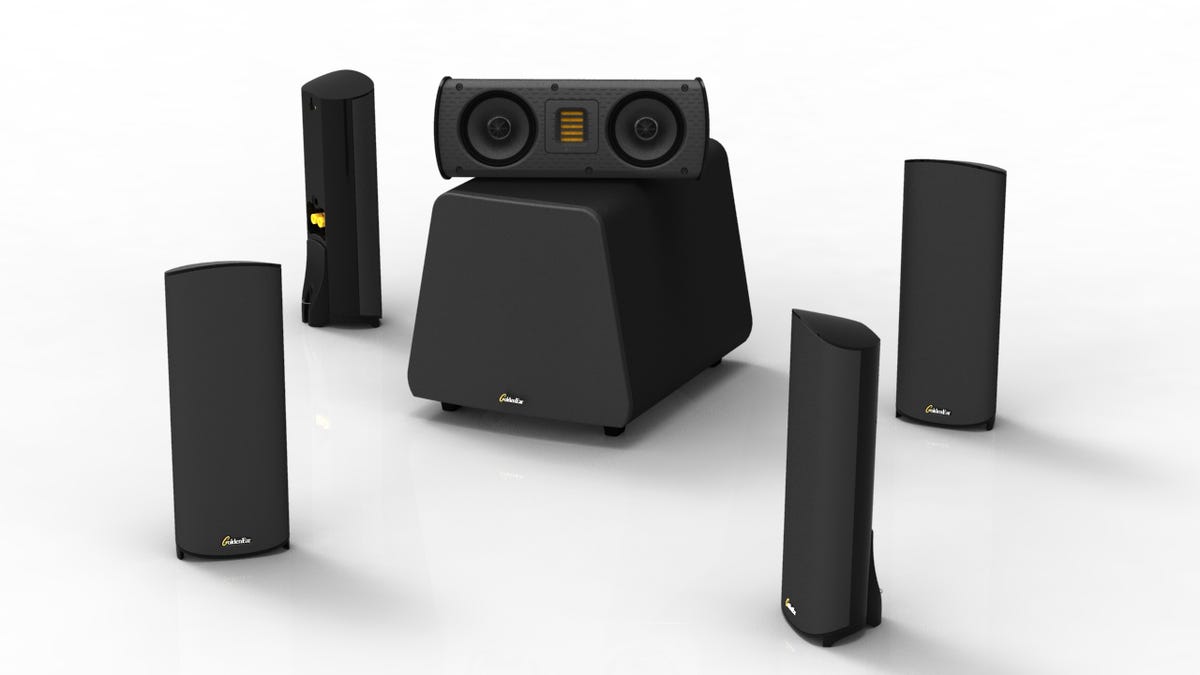GoldenEar SuperCinema 3: How big can a little 5.1 speaker system sound?
GoldenEar Technology ups the ante on lifestyle speakers sound quality.

Sandy Gross was one of the founders of two major speaker companies, Polk Audio and Definitive Technology, and now with GoldenEar Technology he's going for one more. I recently spoke with him about his new venture, and he didn't seem the least bit concerned about entering a rather tough retail market. He is in fact off to a good start and already has 100 brick-and-mortar U.S. dealers, and he will have overseas distributors coming aboard in the near future.
As soon as I heard Gross' SuperCinema 3 I understood why he's so confident. It's a lifestyle-friendly satellite/subwoofer system that sounds remarkable.
It comes with four SuperSat 3 satellites ($249 each), one SuperSat 3C center channel speaker ($249), and a ForceField 3 subwoofer ($499). The gloss black speaker cabinets feel extremely well-built, which is because they're fabricated from injection-molded marble powder infused polymer, a big step up from the more typical plastic, medium-density fiberboard or metal cabinets. That said, the wedge-shape, textured black finished sub is made from MDF, but it also appears to be well-built. GoldenEar Technology speakers are only available in black.
At 12 inches by 4.75 inches, the SuperSat 3 isn't tiny, but it's a mere 2.7 inches deep. The gently curved cabinets are decked out with two 4.5-inch mid/bass drivers, and one high-velocity folded ribbon tweeter (similar in operating principle to a Heil tweeter). Ribbon tweeters are the hot ticket for lots of high-end speakers, including my two personal references, the Magnepan 3.6 and the Zu Essence, but ribbon tweeters are rarely seen on speakers in the SuperSat 3's price range. The tweeter really does play a big part in the speaker's extraordinary sound quality. The SuperSat 3C center speaker sports the same driver complement, but the 3C's drivers are oriented for horizontal speaker placement.
Both speaker models can be wall-mounted via keyhole slots on their backsides, or used with the included table stands. GoldenEar Technology will offer floor stands for the speakers sometime in 2011.
The ForceField 3 subwoofer features a proprietary 1,000-watt digital amp with digital frequency shaping electronics; a front-firing 8-inch active driver; and a special 9.6-by-11.4-inch quadratic planar infrasonic (passive) radiator on the bottom panel. Connectivity options include a direct RCA input as well as speaker-level inputs and outputs. GoldenEar Technology will have an optional wireless kit for the sub for $130 early next year. The sub measures a tidy 11.5 by 15.75 by 11 inches.
We've all heard promises about great sound in a sleek, lifestyle-friendly design before, but this time it's for real. The SuperCinema 3 sounds a lot bigger and better than you'd have any right to expect from something this small. The five SuperSats projected such a seamless, room-filling surround field I almost thought I was listening to seven SuperSats.
The ForceField 3 sub's blend with the SuperSats was perfect (with a 120 Hertz crossover set on the Denon AVR-1911 receiver). The sats and sub together had the poise of a much larger system, and I'd credit some of that to the ForceField 3's extraordinary bass prowess. I've never heard a sub this small go that deep, without forfeiting definition.
The SuperCinema 3's home theater skills were obvious as I played through all of my favorite demo discs, "Master and Commander," "House of Flying Daggers," and "Black Hawk Down." There was an ease to the sound, even when played fairly loud, and at levels beyond the capabilities of most small systems. "Black Hawk Down's" fierce helicopter crash over the SuperCinema 3 may not have fully communicated the brutality you'd get from a full-size tower and large sub based system, but the sound was still more than respectable.
I next checked out Phil Collins' new "Going Back" concert Blu-ray, and there the sound was fully up to snuff. Collins' band has a sweet-sounding brass section, and the drums had tremendous impact and snap. The sense of being at a live concert was excellent, and the applause sounded realistic. I did note some treble softening when I stood up; so it appears that the tweeter's vertical dispersion is limited.
Listening to acoustic jazz CDs in stereo and Dolby Pro Logic II surround I preferred the SuperCinema 3's sound in surround, if only because the sound was a touch too thin in stereo. Piano isn't the easiest instrument to get sounding right on small sat/sub systems, but the SuperCinema 3's sound was spot on. The ribbon tweeters' exceptional clarity really does trump other small speakers I've heard. Hard rock can highlight weaknesses in sat/sub systems, but again, the SuperCinema 3 didn't falter, which amply demonstrated just how well balanced the design really is.
The SuperCinema 3 is the smallest, most affordable system from GoldenEar Technology; the company also offers larger satellites, a tower speaker, and a larger sub. I can hardly wait to hear what the higher-end models can do.
The SuperCinema 3 System won the Best of Innovations Award as the top product in the Home Theater Loudspeakers category in this year's CES Innovations Design and Engineering competition.

